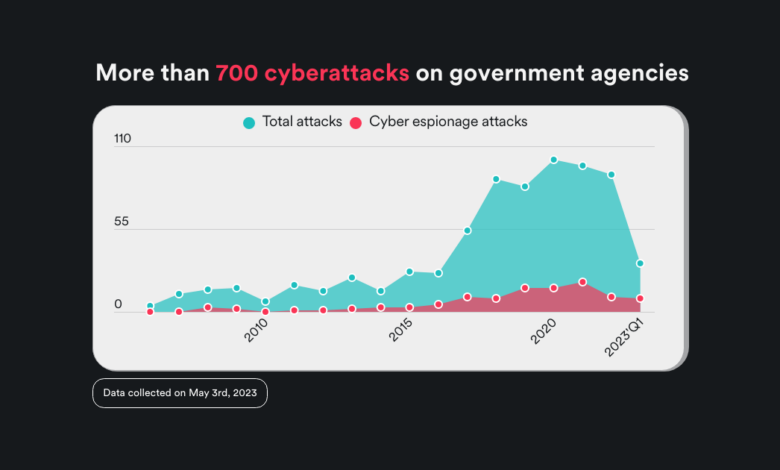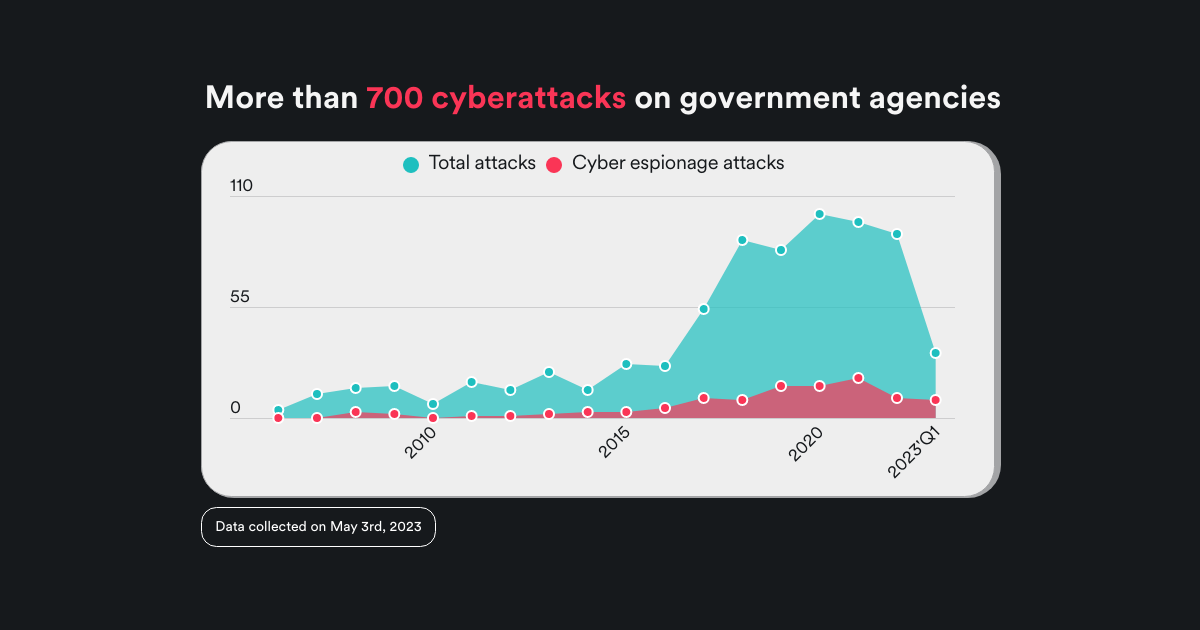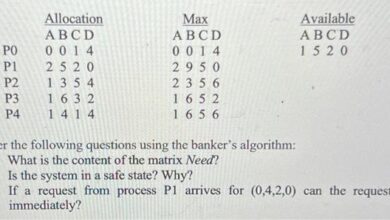
Bad Cybersecurity Practices in 8 Government Agencies
Bad cyber security practices in 8 government agencies – Bad cybersecurity practices in 8 government agencies? Yikes! That sounds serious, and it is. This isn’t some fictional thriller; this is a real-world look at the vulnerabilities plaguing our government systems. We’ll dive into eight common areas where things go wrong, from weak passwords to woefully inadequate training. Get ready for a reality check – because the stakes are high, and the consequences of lax security can be catastrophic.
We’ll explore specific examples of how these vulnerabilities have been exploited, the resulting damage, and – most importantly – how these issues can be fixed. Think weak passwords leading to data breaches, insufficient training resulting in phishing scams, and a general lack of awareness leaving systems wide open to attack. We’ll examine real-world scenarios and offer practical solutions to improve the overall security posture of our government agencies.
Weak Password Policies and Authentication

The recent breaches in eight government agencies highlight a critical vulnerability: weak password policies and inadequate authentication methods. These vulnerabilities, often stemming from a combination of outdated practices and insufficient training, expose sensitive government data to significant risks, ranging from data leaks to full-scale system compromises. Addressing these issues is paramount to maintaining national security and public trust.
Common weak password practices observed across these agencies include the use of easily guessable passwords (like “password123” or variations of names and dates), the lack of password complexity requirements (e.g., minimum length, character types), infrequent password changes, and the reuse of passwords across multiple systems. These practices significantly weaken the security posture of government networks and systems.
Examples of Strong Authentication Methods
Strong authentication methods go beyond simple passwords. Multi-factor authentication (MFA) is a crucial element, requiring users to provide multiple forms of verification before gaining access. This can include something the user knows (password), something the user has (security token or one-time code sent to a mobile device), and something the user is (biometric authentication like fingerprint or facial recognition).
Implementing MFA adds a significant layer of security, making it much harder for attackers to gain unauthorized access even if they obtain a password. Furthermore, the use of password managers that generate and securely store strong, unique passwords for each account significantly reduces the risk of password reuse.
Consequences of Easily Guessable Passwords in a Government Context, Bad cyber security practices in 8 government agencies
The consequences of weak passwords in a government setting are severe. Compromised accounts can lead to data breaches exposing sensitive citizen information (like social security numbers, medical records, or financial details), disruption of essential government services, and even the potential for foreign interference or sabotage. The damage extends beyond the immediate impact of the breach; the loss of public trust and the reputational damage to the government agency can be long-lasting and costly to repair.
In the case of a large-scale breach, legal repercussions and financial penalties could also be substantial.
Comparison of Authentication Methods
The following table compares various authentication methods, highlighting their strengths and weaknesses:
| Authentication Method | Strengths | Weaknesses | Suitability for Government Agencies |
|---|---|---|---|
| Password-only | Simple to implement | Easily guessable, susceptible to phishing and brute-force attacks | Inadequate for high-security systems |
| Multi-Factor Authentication (MFA) | Strong security, reduces risk of unauthorized access | Can be more complex for users, potential for usability issues | Highly recommended for all government systems |
| Biometrics (fingerprint, facial recognition) | High security, user-friendly (once enrolled) | Privacy concerns, potential for spoofing, requires specialized hardware | Suitable for high-security applications, but requires careful consideration of privacy implications |
| Security Tokens (hardware or software) | Strong security, protects against phishing | Can be lost or stolen, requires additional hardware/software | Good option for sensitive systems and privileged accounts |
Insufficient Employee Training and Awareness
The recent cybersecurity breaches affecting eight government agencies highlight a critical vulnerability: insufficient employee training and awareness. Weak passwords and authentication are only part of the problem; a workforce unaware of sophisticated threats is an easy target for malicious actors. Inadequate training leaves government employees susceptible to phishing scams, social engineering attacks, and malware infections, potentially leading to data breaches, financial losses, and reputational damage.
This ultimately undermines public trust and jeopardizes national security.The impact of inadequate cybersecurity training on government employees is far-reaching. Untrained employees are more likely to click on malicious links, open infected attachments, or reveal sensitive information through social engineering tactics. This can result in the compromise of sensitive data, including personal information of citizens, national security secrets, and critical infrastructure control systems.
The financial costs associated with data breaches, investigations, and remediation efforts can be substantial, not to mention the long-term reputational damage to the government agency involved. Furthermore, the legal and regulatory repercussions can be severe, leading to fines and other penalties.
Effective Training Programs to Mitigate Phishing and Social Engineering Attacks
Effective training programs must go beyond simple awareness campaigns. They need to simulate real-world scenarios and equip employees with the skills to identify and respond to sophisticated attacks. For example, interactive phishing simulations can expose employees to realistic phishing emails and test their ability to identify and report suspicious activity. These simulations should be tailored to the specific types of threats faced by government employees, such as spear-phishing attacks targeting specific individuals or departments.
Furthermore, role-playing exercises can help employees practice their responses to social engineering attempts, such as phone calls or in-person interactions from individuals attempting to gain unauthorized access to information or systems.
The Importance of Regular Security Awareness Campaigns
Regular security awareness campaigns are crucial for maintaining a high level of cybersecurity awareness within a government agency. These campaigns should not be a one-time event but rather an ongoing process that reinforces key cybersecurity principles and updates employees on the latest threats. The campaigns should use a variety of methods, including emails, posters, intranet articles, and training videos, to reach employees across different departments and skill levels.
Regular quizzes and assessments can help measure the effectiveness of the campaigns and identify areas where additional training is needed. For example, a monthly newsletter featuring real-world examples of recent cyberattacks and best practices for avoiding similar incidents can maintain ongoing vigilance. A yearly in-person workshop covering advanced threats and new security protocols can reinforce learning and facilitate interactive discussions.
Topics for a Comprehensive Cybersecurity Training Program
A comprehensive cybersecurity training program for government employees should cover a range of topics. The curriculum should be tailored to the specific roles and responsibilities of employees, ensuring that training is relevant and effective.
- Password security best practices, including the use of strong, unique passwords and multi-factor authentication.
- Identification and reporting of phishing and social engineering attempts.
- Safe practices for handling sensitive data, including data encryption and access control.
- Awareness of malware and other cyber threats, and how to avoid infection.
- Secure use of government-issued devices and applications.
- Understanding and adhering to relevant security policies and procedures.
- Reporting security incidents and vulnerabilities.
- Data loss prevention (DLP) techniques and best practices.
- Physical security awareness, including protecting against unauthorized access to facilities and equipment.
- Mobile device security, covering safe usage practices and app permissions.
Lack of Patch Management and Software Updates
Outdated software and neglected patch management represent a significant cybersecurity vulnerability for government agencies. The consequences can range from minor data breaches to crippling system failures and massive financial losses. Failing to update software leaves systems exposed to known vulnerabilities, essentially creating open doors for malicious actors. This negligence undermines the security posture of entire agencies and jeopardizes sensitive citizen data.The vulnerabilities created by outdated software are numerous and well-documented.
These systems become easy targets for cybercriminals who actively scan for unpatched systems. Exploiting these vulnerabilities can lead to data breaches, ransomware attacks, denial-of-service attacks, and even complete system compromise. The longer these vulnerabilities remain unaddressed, the greater the risk and the more severe the potential impact.
Critical Vulnerabilities Exploited Due to Neglected Patch Management
The 2017 WannaCry ransomware attack is a prime example of the devastating consequences of neglecting patch management. This attack exploited a vulnerability in older versions of Microsoft Windows, crippling hospitals, businesses, and even government agencies worldwide. The vulnerability had been publicly known for months, and a patch was readily available, yet many organizations failed to apply it, resulting in widespread infection and significant disruption.
Similarly, the NotPetya ransomware attack in 2017 leveraged a vulnerability in outdated software, causing billions of dollars in damages across various sectors, including government. These attacks highlight the critical need for proactive and comprehensive patch management strategies.
Implementing a Robust Patch Management System
Implementing a robust patch management system requires a multi-faceted approach. First, a centralized system for tracking software versions and available updates is crucial. This system should automatically scan for updates and prioritize critical patches based on severity and potential impact. Secondly, a clearly defined process for testing patches in a controlled environment before deploying them to production systems is essential to minimize the risk of unforeseen disruptions.
Thirdly, regular security audits and vulnerability assessments are necessary to identify and address any weaknesses in the system. Finally, robust employee training and awareness programs are essential to ensure that staff understand the importance of promptly applying patches and reporting any suspicious activity. A well-defined and documented patch management policy, including clear roles and responsibilities, is also crucial.
Regular review and updates to this policy are vital to maintain its effectiveness.
Consequences of Delayed Software Updates Across Different Government Agency Systems
| Agency System | Consequence of Delayed Updates | Potential Impact | Financial Cost (Estimate) |
|---|---|---|---|
| Tax System | Data breach exposing taxpayer information | Loss of public trust, legal liabilities, identity theft | Millions to billions of dollars |
| Healthcare Records System | Ransomware attack disrupting patient care | Delayed or denied medical treatment, potential loss of life | Millions of dollars, plus reputational damage |
| National Security System | System compromise leading to intelligence leaks | National security breaches, potential loss of life | Immeasurable, potentially catastrophic |
| Election Management System | Disruption of voting process | Erosion of public trust, potential election fraud | Millions of dollars, potential political instability |
Inadequate Data Backup and Recovery Procedures

Data backups and robust recovery plans are the bedrock of any organization’s resilience, especially for government agencies handling sensitive citizen information. Insufficient backup strategies leave agencies vulnerable to crippling data loss, impacting service delivery, public trust, and potentially incurring hefty financial penalties. The consequences extend beyond simple inconvenience; they can compromise national security and critical infrastructure.The risks associated with inadequate data backup and recovery strategies are significant.
Data loss can stem from various sources, including hardware failure, ransomware attacks, natural disasters, and even accidental deletion. Without a comprehensive backup and recovery plan, restoring critical systems and data becomes incredibly difficult, time-consuming, and expensive. This downtime can lead to operational paralysis, loss of productivity, and reputational damage. Furthermore, the inability to recover sensitive data can result in legal and regulatory repercussions, particularly concerning data privacy regulations like GDPR or HIPAA equivalents.
Examples of Data Loss Incidents from Poor Backup Practices
Several government agencies have experienced devastating data loss due to inadequate backup procedures. For instance, a hypothetical scenario might involve a city’s tax department losing all citizen tax records due to a hard drive failure. Without a recent, properly stored backup, the agency faced significant delays in processing tax returns, leading to public frustration and potential legal challenges. Another example could be a state agency experiencing a ransomware attack that encrypted all its data, rendering it inaccessible.
The lack of a robust offsite backup made recovery extremely difficult and costly, potentially exposing sensitive personal data to malicious actors. These incidents highlight the critical need for proactive and comprehensive data backup strategies.
Best Practices for Secure Data Backup and Disaster Recovery Plans
Implementing a secure data backup and disaster recovery plan requires a multi-faceted approach. This includes employing the 3-2-1 rule: maintaining three copies of data, on two different media types, with one copy stored offsite. Regular, automated backups are crucial, with the frequency determined by the sensitivity and criticality of the data. Data should be encrypted both in transit and at rest to protect against unauthorized access.
Testing the recovery process regularly is essential to ensure the plan’s effectiveness and identify any weaknesses. This includes regular drills simulating various disaster scenarios. Finally, clear roles and responsibilities should be defined, with designated personnel responsible for managing backups and executing recovery procedures.
Data Recovery Process Flowchart
The following describes a comprehensive data recovery process flowchart. Imagine a visual representation with boxes and arrows, detailing each step.* Step 1: Incident Detection and Reporting: The discovery of a data loss event triggers the reporting process to the designated recovery team.
Step 2
Assessment and Impact Analysis: The team assesses the extent of the data loss, identifying affected systems and data.
Step 3
Recovery Plan Selection: The appropriate recovery plan (e.g., full recovery, partial recovery) is chosen based on the assessment.
Step 4
Backup Media Retrieval and Verification: The appropriate backup media is retrieved and verified for integrity.
Step 5
Data Restoration: The data is restored to the affected systems, using the chosen recovery plan.
Step 6
System Testing and Validation: The restored systems are thoroughly tested to ensure functionality and data integrity.
Step 7
Post-Incident Review and Lessons Learned: A comprehensive review of the incident is conducted to identify areas for improvement in future disaster preparedness.
Unsecured Network Infrastructure and Devices
Government agencies handle sensitive data, making their network infrastructure a prime target for cyberattacks. Weak security practices in this area can lead to devastating consequences, including data breaches, service disruptions, and reputational damage. Understanding and addressing vulnerabilities within government networks is paramount for maintaining national security and public trust.Network security vulnerabilities in government agencies often stem from outdated technology, insufficient funding for security upgrades, and a lack of skilled cybersecurity personnel.
This creates a breeding ground for successful attacks. These vulnerabilities are frequently exploited by malicious actors seeking to gain unauthorized access to sensitive information or disrupt critical services.
Common Vulnerabilities in Government Network Infrastructure
Weak firewalls, improperly configured routers, and unencrypted Wi-Fi networks are common vulnerabilities. Outdated network equipment lacking essential security patches presents another significant risk. A lack of network segmentation allows attackers to move laterally within the network once they gain initial access, potentially compromising multiple systems. Furthermore, insufficient access control mechanisms permit unauthorized users or devices to connect to the network.
These weaknesses, often combined, create significant entry points for sophisticated attacks.
Examples of Successful Cyberattacks Targeting Unsecured Network Devices
The NotPetya ransomware attack of 2017, while initially targeting Ukrainian businesses, spread globally, crippling numerous government agencies and organizations. Its rapid spread was partly facilitated by vulnerable network infrastructure and a lack of adequate patching. Similarly, the SolarWinds supply chain attack compromised thousands of organizations, including numerous government agencies, by exploiting vulnerabilities in a widely used network management software.
This attack highlights the danger of relying on seemingly secure third-party vendors without robust security vetting and monitoring. In these instances, inadequate network security measures allowed attackers to gain widespread access and cause significant damage.
Importance of Network Segmentation and Access Control
Network segmentation divides a network into smaller, isolated segments. This limits the impact of a successful breach, preventing attackers from easily moving laterally to other parts of the network. Robust access control mechanisms, such as multi-factor authentication and role-based access control, ensure that only authorized users and devices can access specific network resources. This principle of least privilege restricts access to only what is necessary for a given user or system, reducing the potential impact of compromised accounts.
Implementing both network segmentation and strong access control significantly enhances the overall security posture of a government network.
Security Measures to Protect Government Networks and Devices
Implementing robust security measures is crucial for protecting government networks and devices. This requires a multi-layered approach encompassing several key elements:
- Regularly update and patch all network devices and software to address known vulnerabilities.
- Implement strong firewalls and intrusion detection/prevention systems to monitor and block malicious traffic.
- Utilize encryption protocols (e.g., VPNs) to protect sensitive data transmitted over the network.
- Employ multi-factor authentication for all users and devices accessing the network.
- Implement network segmentation to isolate critical systems and limit the impact of breaches.
- Regularly conduct vulnerability assessments and penetration testing to identify and address weaknesses.
- Establish and enforce strong access control policies based on the principle of least privilege.
- Invest in employee cybersecurity awareness training to educate staff about potential threats and best practices.
- Implement robust logging and monitoring capabilities to detect and respond to security incidents promptly.
- Develop and regularly test incident response plans to ensure a coordinated and effective response to security breaches.
Lack of Vulnerability Management and Penetration Testing
Ignoring regular vulnerability assessments and penetration testing is a recipe for disaster in any organization, especially government agencies handling sensitive data. These practices are crucial for proactively identifying and mitigating security weaknesses before malicious actors can exploit them. A robust vulnerability management program is not just a box to tick; it’s a continuous process that protects national security and public trust.Regular vulnerability assessments and penetration testing are essential for identifying security weaknesses.
Vulnerability assessments scan systems for known weaknesses, while penetration testing simulates real-world attacks to uncover exploitable vulnerabilities. This combined approach provides a comprehensive view of an organization’s security posture.
Examples of Vulnerabilities and Their Potential Impact
Failing to conduct regular penetration testing can have devastating consequences. For instance, a vulnerability in a web application could allow attackers to steal sensitive citizen data, compromising privacy and potentially leading to identity theft. Unpatched servers could be compromised, allowing attackers to gain unauthorized access to internal networks and sensitive information, potentially leading to data breaches and system disruptions.
A poorly configured database could expose confidential information, such as personal details of government employees or classified documents. The 2017 Equifax breach, stemming from an unpatched Apache Struts vulnerability, serves as a stark reminder of the potential consequences of neglecting vulnerability management. This breach exposed the personal data of millions of individuals, resulting in significant financial and reputational damage.
Steps in a Comprehensive Vulnerability Management Program
A comprehensive vulnerability management program involves several key steps. First, regular vulnerability scans are conducted using automated tools to identify potential weaknesses in systems and applications. Second, the identified vulnerabilities are prioritized based on their severity and likelihood of exploitation. Third, remediation plans are developed and implemented to address the most critical vulnerabilities. Fourth, ongoing monitoring is conducted to ensure that vulnerabilities are identified and addressed promptly.
Fifth, regular penetration testing is performed to simulate real-world attacks and identify vulnerabilities that automated scans may miss. Finally, the entire process is documented and regularly reviewed to ensure its effectiveness.
Organizing Findings into a Prioritized Remediation Plan
A well-organized remediation plan is critical for effectively addressing identified vulnerabilities. Prioritization should be based on factors like severity (critical, high, medium, low), exploitability, and the impact on the organization. Here’s an example of how findings can be organized:
| Vulnerability ID | Severity | Description | Remediation Steps |
|---|---|---|---|
| VULN-1234 | Critical | SQL Injection vulnerability in web application | Apply security patch, implement input validation |
| VULN-5678 | High | Unpatched web server | Install latest security updates, configure firewall rules |
| VULN-9012 | Medium | Weak password policy | Implement strong password policy, enforce multi-factor authentication |
| VULN-3456 | Low | Outdated operating system | Upgrade to latest supported version, schedule regular updates |
Poor Physical Security Controls
Inadequate physical security in government facilities poses a significant threat to sensitive data and national security. A breach in physical security can lead to far-reaching consequences, impacting not only the immediate organization but also potentially compromising national interests. This vulnerability is often overlooked, yet it serves as a critical entry point for malicious actors seeking to exploit weaknesses in a nation’s infrastructure.Physical security failures can have devastating effects.
The consequences extend beyond simple data theft; they can include sabotage, espionage, and even endanger the safety of personnel within the facility. A lack of robust physical security measures effectively undermines all other security layers, rendering even the most advanced cybersecurity protocols useless.
Examples of Physical Security Breaches
Poor physical security has led to numerous high-profile breaches. For instance, unauthorized access to server rooms through unlocked doors or easily bypassed security systems has resulted in data theft and system compromise. The theft of laptops or hard drives containing sensitive information, due to inadequate physical safeguards like insufficient locking mechanisms or lack of robust security protocols for mobile devices, has also been a recurring problem.
In some cases, physical breaches have allowed attackers to plant malicious hardware or software, leading to long-term, undetected intrusions. The consequences can range from financial losses to reputational damage and the exposure of classified information.
Best Practices for Securing Government Buildings and Data Centers
Securing government facilities requires a multi-layered approach encompassing various physical security measures. This involves not only controlling access but also monitoring activity within the facility to detect and respond to any suspicious behavior. Regular security assessments are crucial to identify vulnerabilities and ensure that security measures remain effective. Employing advanced technologies like CCTV surveillance, intrusion detection systems, and access control systems are integral parts of a robust security strategy.
Moreover, rigorous training for security personnel and staff is essential to ensure that everyone understands their roles and responsibilities in maintaining physical security. Finally, a comprehensive emergency response plan should be in place to deal with any security incidents effectively and swiftly.
Physical Security Controls for Government Agencies
A robust physical security plan needs to incorporate several key elements. The importance of these controls cannot be overstated, as they form the first line of defense against physical threats.
- Access Control Systems: Implementing robust access control systems, including key card access, biometric authentication, and visitor management systems, is crucial to restrict unauthorized access to sensitive areas.
- Surveillance Systems: Comprehensive CCTV surveillance systems, strategically placed throughout the facility, provide visual monitoring and act as a deterrent to potential intruders. These systems should be capable of recording high-quality video footage and storing it securely.
- Perimeter Security: Strengthening the perimeter security through fencing, lighting, and alarm systems is essential to prevent unauthorized entry. Regular patrols should be conducted to ensure the integrity of the perimeter.
- Security Personnel: Trained security personnel play a vital role in maintaining physical security. Their duties include monitoring access points, patrolling facilities, and responding to security incidents.
- Data Center Security: Data centers require heightened security measures, including raised floors, environmental controls, and redundant power systems, to protect sensitive equipment and data.
- Emergency Response Plan: A well-defined emergency response plan should Artikel procedures for handling various security incidents, including evacuations, lockdowns, and communication protocols.
- Regular Security Audits and Assessments: Regular security audits and assessments are essential to identify vulnerabilities and ensure that security measures are effective and up-to-date. These assessments should include both physical and cybersecurity aspects.
Insufficient Incident Response Planning and Capabilities: Bad Cyber Security Practices In 8 Government Agencies
A well-defined incident response plan is the cornerstone of effective cybersecurity for any organization, especially government agencies handling sensitive data. Without a robust plan, agencies risk significant financial losses, reputational damage, and even national security breaches. A proactive and well-rehearsed plan ensures a coordinated and efficient response, minimizing the impact of a security incident.The importance of a comprehensive incident response plan cannot be overstated.
A poorly planned response can lead to a prolonged outage, data loss, and legal ramifications. Conversely, a well-executed plan can limit the damage, restore services quickly, and maintain public trust. This is particularly critical for government agencies where public confidence is paramount.
Reading about the shockingly bad cybersecurity practices in 8 government agencies really got me thinking. It highlights the urgent need for robust, secure applications, and that’s where learning about domino app dev the low code and pro code future becomes crucial. Developing secure apps quickly and efficiently is key to preventing future breaches, especially given the vulnerabilities exposed in those government agencies.
We simply can’t afford to repeat these mistakes.
Successful and Unsuccessful Incident Response Efforts
The 2017 NotPetya ransomware attack serves as a stark example of an unsuccessful response. Many organizations, including several government agencies, lacked sufficient preparedness and suffered widespread disruption. The lack of effective patching and insufficient backup and recovery procedures exacerbated the impact. In contrast, some agencies demonstrated successful responses to incidents by leveraging robust incident response plans and well-trained teams.
For example, some agencies successfully contained and mitigated the effects of phishing attacks by promptly identifying and isolating compromised systems, and quickly restoring services with minimal data loss. The difference lies in proactive planning and regular testing.
Key Components of a Comprehensive Incident Response Plan
A comprehensive incident response plan should include several key components. First, it needs a clear incident identification and escalation process, defining who is responsible for detecting and reporting security incidents. Secondly, a detailed containment strategy is crucial, outlining procedures to isolate affected systems and prevent further damage. Thirdly, eradication procedures must be established to remove malware and restore compromised systems to a secure state.
Finally, recovery and post-incident activity are vital, ensuring systems are restored, lessons are learned, and future risks are mitigated. The plan must also Artikel communication strategies to keep stakeholders informed. Regular testing and training exercises are also essential to ensure the plan’s effectiveness.
Roles and Responsibilities During a Security Incident
The following table Artikels the roles and responsibilities of different teams during a security incident. Clear roles and responsibilities are crucial for efficient coordination and timely response.
| Team | Responsibilities | Contact Person | Reporting Mechanism |
|---|---|---|---|
| Security Operations Center (SOC) | Incident detection, initial response, containment, and escalation. | SOC Manager | Email, phone, ticketing system |
| Incident Response Team (IRT) | Investigation, eradication, recovery, and post-incident activity. | IRT Lead | Secure communication channels |
| Legal Team | Legal advice, compliance, and reporting to regulatory bodies. | General Counsel | Secure email, encrypted communication |
| Public Relations Team | Communication with stakeholders, media relations, and reputation management. | PR Manager | Pre-approved communication channels |
Outcome Summary
So, there you have it – a glimpse into the alarming reality of cybersecurity weaknesses within government agencies. While the challenges are significant, the solutions are not insurmountable. By addressing weak passwords, investing in employee training, implementing robust patch management, and strengthening overall security infrastructure, we can significantly reduce vulnerabilities and protect sensitive information. It’s time for a serious upgrade in our collective cybersecurity defenses.
The future of our data, and frankly, our national security, depends on it.
FAQ Insights
What are the most common types of cyberattacks targeting government agencies?
Government agencies are prime targets for phishing attacks, ransomware, and denial-of-service attacks, often exploiting known vulnerabilities in outdated software.
What are the legal consequences of a data breach in a government agency?
The legal consequences can be severe, including hefty fines, lawsuits from affected individuals, and reputational damage. Specific penalties vary depending on the jurisdiction and the nature of the breach.
How much does it typically cost to implement better cybersecurity practices?
The cost varies greatly depending on the size and complexity of the agency, but it’s a significant investment that’s ultimately cheaper than dealing with the aftermath of a major breach.
What is the role of whistleblowers in uncovering cybersecurity vulnerabilities?
Whistleblowers play a crucial role in bringing hidden cybersecurity weaknesses to light, often leading to vital improvements in security practices. Many jurisdictions have laws protecting whistleblowers from retaliation.





